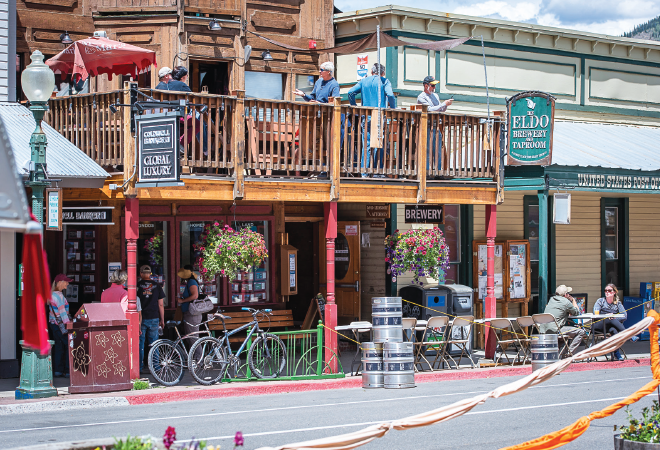Bike issues at the top of the list
By Mark Reaman
A week into the great 2020 Elk Avenue reconfiguration, it appears the Crested Butte business district outdoor attraction is consistently busy with diners and shoppers.
The reconfiguration that opened June 16 changed Elk Avenue to a single lane of one-way traffic that allows local businesses to expand some seating and displays onto public property, including parts of the street. Town officials say the change appears to be working but it can continue to be tweaked as needed. The two immediate areas of feedback the town is hearing appear to be bike traffic issues and the general look of seating areas.
“Overall, I think Elk Avenue from a design perspective is working well,” said town planner Mel Yemma. “I’m trying to have many individual conversations with folks to obtain a lot of feedback before the next Town Council meeting and we’re currently putting together a brief survey to share with businesses. Overall, we are very open to hearing feedback and suggested changes and ensuring that the reconfiguration is working well.”
Crested Butte chief marshal Mike Reily said everyone is getting used to the new plan and generally it is working. “From the police perspective it seems to be working pretty well. The bus drivers (and other drivers) would really appreciate cyclists travelling the correct direction and for skateboarders to stay off of Elk, Sixth and Whiterock to reduce inevitable conflict. Overall, the setup seems to be working but it is hard to get on Elk to use radar in our Tahoes. The electric motorcycles, however, work very well to monitor vehicles travelling over 10 miles per hour,” said Reily.
Yemma said as far as the look of the street, town gardener Les Choy, along with some town leadership personnel, is currently working through planting the large flower boxes that delineate some sections. “I think it’s great how many businesses have individualized their section and the chamber of commerce is currently organizing a ‘sponsor’ a seating area program to help support businesses with planting flowers and other things,” said Yemma.
“As for bike access, we unfortunately couldn’t fit a formal bike lane, especially a counter-flow bike lane,” Yemma explained. “If we were to fit in a bike lane, we would have to remove parking and seating areas from at least the south side of the street, which would defeat the main intent of the reconfiguration. But we understand that this was a large request from the community that we unfortunately couldn’t meet with this design. We ask that bikers remember the rules of the road and that they are subject to the same traffic rules as vehicles. We encourage bikers to ride with traffic, as cars should not need to pass a biker when they are driving at 10 mph.”
Reily agreed that the bikes on Elk issue needed to be ironed out. “On June 17 we had an adult cyclist get doored,” he said. “The primary violation involved the driver of the truck not observing the cyclist and opening his door into the lane of travel, which clipped the end of the rider’s bars. Drivers have an obligation to make sure the lane is clear before opening their doors. Cyclists should ride outside of the door opening distance to avoid getting clipped and to increase their visibility.
“There has been some confusion that a bike lane has been created, which isn’t so,” Reily continued. “The center two white lines define the 12-foot-wide travel lane, while the outer white lines define the parking lanes. The sets of white lines that are close together don’t define a bike lane but instead encompass the two-foot safety buffer and the extension of the seating and retail areas. The best ‘bike lane’ is still the main travel lane of the roadway. To quote Effective Cycling, ‘Cyclists fare best when they act and are treated as drivers of vehicles.’ If bike riders will ride as far to the right as is practicable (per the law) and obey the one-way direction of the road they will be much safer; especially mixing with 10 mph traffic.”
Business feedback has been positive from some, wait-and-see from others and negative from a few. “The majority of businesses I have spoken with seem to be happy with the opportunity to get some space and serve a greater number of customers,” said Reily. He said it appears most patrons are cleaning up after themselves and not trashing the public tables, although the picnic tables are harder to clean, given their “grippy” surface.
“We are currently working through some tweaks, where some additional businesses are requesting seating areas and some might prefer to go back to parking,” added Yemma. “We will be talking about it all at the next council meeting on July 6.”
 The Crested Butte News Serving the Gunnison Valley since 1999
The Crested Butte News Serving the Gunnison Valley since 1999


